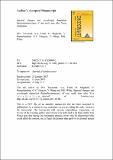Files in this item
Spectral changes and wavelength dependent thermoluminescence of rare earth ions after X-ray irradiation
Item metadata
| dc.contributor.author | Townsend, P. D. | |
| dc.contributor.author | Finch, A. A. | |
| dc.contributor.author | Maghrabi, M. | |
| dc.contributor.author | Ramachandran, V. | |
| dc.contributor.author | Vázquez, G. V. | |
| dc.contributor.author | Wang, Y. | |
| dc.contributor.author | White, D. R. | |
| dc.date.accessioned | 2018-07-21T23:34:44Z | |
| dc.date.available | 2018-07-21T23:34:44Z | |
| dc.date.issued | 2017-12 | |
| dc.identifier | 250562847 | |
| dc.identifier | bb63c61f-46f7-4339-bafe-a32f2a6c6170 | |
| dc.identifier | 85026377517 | |
| dc.identifier | 000413037400083 | |
| dc.identifier.citation | Townsend , P D , Finch , A A , Maghrabi , M , Ramachandran , V , Vázquez , G V , Wang , Y & White , D R 2017 , ' Spectral changes and wavelength dependent thermoluminescence of rare earth ions after X-ray irradiation ' , Journal of Luminescence , vol. 192 , pp. 574-581 . https://doi.org/10.1016/j.jlumin.2017.07.041 | en |
| dc.identifier.issn | 0022-2313 | |
| dc.identifier.other | RIS: urn:8E0CE07E3D5F35FB091CEFE84572B5EA | |
| dc.identifier.other | ORCID: /0000-0002-3689-1517/work/38002304 | |
| dc.identifier.uri | https://hdl.handle.net/10023/15623 | |
| dc.description | Y. Wang would like to thank the support of the Fundamental Research Funds for the Central Universities of China, the National Natural Science Foundation of China (No.51472224, No.11205134), and Beijing Higher Education Young Elite Teacher Project (YETP0640). | en |
| dc.description.abstract | The thermoluminescence spectra of rare earth doped materials after X-ray irradiation typically vary with the glow peak temperature. Additionally, there are many examples where, for the same dopant ion, the expected component emission lines peak, but at different temperatures. This unusual behaviour is discussed in terms of changes in proximity of coupling between trapping and recombination sites. Changes in the energy barriers for recombination influence alternative routes for charge transfer to rare earth sites which can involve different higher energy states of the rare earth dopants. Proposed mechanisms include selective tunnelling, or barrier crossing, in addition to normal charge transfer from remote trapping sites. The model successfully describes numerous examples in terms of the energy scheme for the rare earth ions. Whilst the standard emission lines are recorded in the glow curve spectra they do not always occur at the same temperature, and, even for the same rare earth dopant, they can differ by as much as 30 °C. These wavelength dependent variations in peak temperature not only offer information on the proximity of trap and recombination sites, but also introduce issues in conventional activation energy analysis when recording is with polychromatic light. The concepts are relevant for related types of measurement, such as optically stimulated thermoluminescence. | |
| dc.format.extent | 8 | |
| dc.format.extent | 1028185 | |
| dc.language.iso | eng | |
| dc.relation.ispartof | Journal of Luminescence | en |
| dc.subject | Thermoluminescence | en |
| dc.subject | Model | en |
| dc.subject | Wavelength dependent | en |
| dc.subject | QC Physics | en |
| dc.subject | GE Environmental Sciences | en |
| dc.subject | NDAS | en |
| dc.subject.lcc | QC | en |
| dc.subject.lcc | GE | en |
| dc.title | Spectral changes and wavelength dependent thermoluminescence of rare earth ions after X-ray irradiation | en |
| dc.type | Journal article | en |
| dc.contributor.sponsor | NERC | en |
| dc.contributor.institution | University of St Andrews. School of Earth & Environmental Sciences | en |
| dc.contributor.institution | University of St Andrews. Marine Alliance for Science & Technology Scotland | en |
| dc.contributor.institution | University of St Andrews. Scottish Oceans Institute | en |
| dc.contributor.institution | University of St Andrews. St Andrews Isotope Geochemistry | en |
| dc.identifier.doi | https://doi.org/10.1016/j.jlumin.2017.07.041 | |
| dc.description.status | Peer reviewed | en |
| dc.date.embargoedUntil | 2018-07-22 | |
| dc.identifier.grantnumber | NE/H002715/1 | en |
This item appears in the following Collection(s)
Items in the St Andrews Research Repository are protected by copyright, with all rights reserved, unless otherwise indicated.

